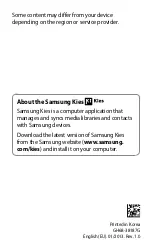
Section 4A: Safety Guidelines
153
What are wireless telephone base stations?
Fixed antennas used for wireless telecommunications are referred to as cellular
base stations, cell stations, PCS (“Personal Communications Service”) stations
or telephone transmission towers. These base stations consist of antennas and
electronic equipment. Because the antennas need to be high in the air, they are
often located on towers, poles, water tanks, or rooftops. Typical heights for
freestanding base station towers are 50-200 feet.
Some base stations use antennas that look like poles, 10 to 15 feet in length,
that are referred to as “omni-directional” antennas. These types of antennas are
usually found in rural areas. In urban and suburban areas, wireless providers
now more commonly use panel or sector antennas for their base stations.
These antennas consist of rectangular panels, about 1 by 4 feet in dimension.
The antennas are usually arranged in three groups of three antennas each. One
antenna in each group is used to transmit signals to wireless phones, and the
other two antennas in each group are used to receive signals from wireless
phones.
At any base station site, the amount of RF energy produced depends on the
number of radio channels (transmitters) per antenna and the power of each
transmitter. Typically, 21 channels per antenna sector are available. For a typical
cell site using sector antennas, each of the three transmitting antennas could be
connected to up to 21 transmitters for a total of 63 transmitters. However, it is
unlikely that all of the transmitters would be transmitting at the same time.
When omni-directional antennas are used, a cellular base station could
theoretically use up to 96 transmitters, but this would be very unusual, and,
once again, it is unlikely that all transmitters would be in operation
simultaneously. Base stations used for PCS communications generally require
fewer transmitters than those used for cellular radio transmissions, since PCS
carriers usually have a higher density of base station antenna sites.
Are wireless telephone base stations safe?
The electromagnetic RF signals transmitted from base station antennas stations
travel toward the horizon in relatively narrow paths. For example, the radiation
pattern for an antenna array mounted on a tower can be likened to a thin
pancake centered around the antenna system. The individual pattern for a
single array of sector antennas is wedge-shaped, like a piece of pie. As with all
forms of electromagnetic energy, the power decreases rapidly as one moves
away from the antenna. Therefore, RF exposure on the ground is much less
than exposure very close to the antenna and in the path of the transmitted
radio signal. In fact, ground-level exposure from such antennas is typically
thousands of times less than the exposure levels recommended as safe by
expert organizations. So exposure to nearby residents would be well within
safety margins.
Cellular and PCS base stations in the United States are required to comply with
limits for exposure recommended by expert organizations and endorsed by
government agencies responsible for health and safety. Measurements made
near cellular and PCS base station antennas mounted on towers have confirmed
that ground-level exposures are typically thousands of times less than the
exposure limits adopted by the FCC. In fact, in order to be exposed to levels at
Содержание A660 - SPH Cell Phone
Страница 1: ...WJ23 06_LMa660_111203_F1 PCS Vision Phone SPH a660 User s Guide ...
Страница 9: ...Getting Started Section 1 ...
Страница 16: ...Your PCS Vision Phone Section 2 ...
Страница 18: ...Section 2A Your PCS Vision Phone The Basics 10 Front View of Your Phone ...
Страница 106: ...PCS Service Features Section 3 ...
Страница 148: ...Safety Guidelines and Warranty Information Section 4 ...
















































